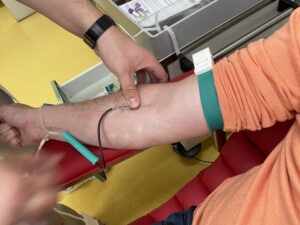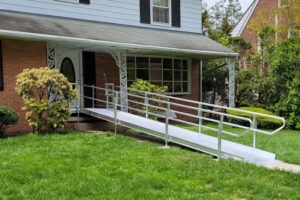
This winter, don’t despair when snow days and holidays leave you with a house full of bored and bickering kids. These fun winter-break activities will keep your children occupied and happy both indoors and out – throughout the frosty season!
Ice Candles
Enchant your children with a magical and easy outdoor activity that will transform your backyard into a winter wonderland.
- Age: Preschool and up
- Time: About 20 minutes
- Type of Activity: Backyard fun
Materials needed:
- Small plastic tub or bucket (a summer beach pail is an ideal size).
- Tin can or small plastic cup.
A few strategically placed ice candles can turn your backyard into a winter’s evening wonderland. Ice candles are easy to make, and best of all, cost next to nothing.
The trick:
The first step to creating an ice candle is to make a mold. This is done by filling a bucket or pail with cold tap water and placing a tin can or cup in the center. Weigh it down with enough small rocks to almost, but not quite, sink it.
Place the bucket outside on the porch or in the freezer until the water is frozen solid. Carefully remove the block of ice from the pail or bucket (you might need to loosen the ice by running warm tap water over the bucket’s surface for a few moments). Once the ice is free from the bucket, the next step is to remove the tin can or plastic cup from the center of the block. (If the can or cup seems locked in the ice you can fill it with warm water to make removal easier.)
Once the ice has been removed from the pail and the cup from the center of the block, you’ve got your basic ice candle. Just place a small candle at the bottom of the well where the cup used to be. Bingo! You’ve just made an ice candle!
Hints: To keep the can or cup from “drifting off center” you may want to anchor it in place by placing a stick across the top of the pail and taping the cup or can to the stick. An inverted saucepan cover will also do the trick — the knob at the top will prevent the cup or can from drifting too far from the center.
Rainbow ice candles
Essentially you follow the steps outlined above, except you will build your candle in stages. Fill your bucket with 1/2 inch cold tap water and let freeze. When your first layer has frozen solid, add another 1/2 inch of VERY COLD tap water and add several drops of food coloring. Freeze and repeat the process with a different food coloring for each layer. Don’t forget to put a can or cup in the center to make space for your candle.
Holiday Baskets
It’s never too late to do volunteer work with a fun and easy crafts project. Feel good by collaborating with your kids to help those in need.
Read a Good Book
As the snow falls gently outside, curl up with your kids, a blanket, and a good book. Read aloud or silently on a cozy winter day.
Snow Sculptures
It’s no ordinary snow day when you transform your snowman into a work of art! Your kids will jump at the chance to show off their creativity and impress you with their snow creations.
Movie Marathon
Have a movie marathon with all the best Oscar-winning films that are appropriate for kids. Introduce your kids to old classics and get acquainted with a few of the newer ones.
Rainsticks from Recyclables
When it’s too cold and wet to brave the outdoors, set your kids up with an earth-friendly craft activity that will keep them busy and give you peace of mind.
- Age: Upper Elementary and Up
- Time: An hour or more
- Type of Activity: Art
Materials needed:
- Cardboard carpet tube (these are usually 3″ to 4″ in diameter. In this case, the bigger the better)
- Corrugated cardboard (an old box will do just fine)
- Packing or masking tape that is about 2″ wide
- Glue (hot glue, white glue, carpenter’s glue — it’s your choice)
- A power drill or an awl — ADULT ASSISTANCE REQUIRED
- Flat-head spiral nails (about 2″-3″ long)
- A hammer
- Scissors
- Paints & paintbrushes
- Water
Found objects for decorating and noise-making objects like rice, corn kernels, sunflower seeds, or pistachio nut shells.
What to do:
Do your kids have some time on their hands? Want to make a fantastic creation? Super! Creating a rainstick is more than a rainy-day activity — it’s fun!
Ready, set, go, and cut a piece of carpet tube to about three to five feet. An adult should help with this step. Next, have an adult drill tiny holes (smaller than your flat-head spiral nails) around the entire area of the carpet tube. This will make hammering the nails easier and safer. If you don’t have a drill or are uncomfortable using one, just use an awl to poke your holes. Now, using a hammer, put the flat-headed spiral nails into the holes that you have drilled. When you look into your tube, you should see a maze of nails.
Now you’re ready to “plug” one end of your tube by placing it on a piece of cardboard, tracing around the tube, and cutting out the circle. Repeat the process so you have a circle for both ends. Attach the cardboard circle using glue or tape. When one end of your tube is sealed, put a few cups of sunflower seeds, rice, corn kernels, or a combination of all three, into the tube. You will start to hear just how many or how few cups it will take to achieve the desired sound. Remember, you don’t want to make the rainstick too heavy, so don’t put too much filling in. Once you are satisfied with the sound, you can seal the other end of the tube with the second circle and enjoy!
Backyard Weather Stations
Your kids can learn something even on the days when they stay home from school (just don’t let them in on it)! This educational outdoor activity will teach your kids about weather and record keeping.
- Age: Elementary and up
- Time: 2 hours or more
- Type of Activity: Backyard science
Materials needed:
- Thermometer: To record the temperature.
- Rain Gauge: To measure rainfall.
- Wind/Weather Vane: To record wind direction.
- Barometer: To measure atmospheric pressure.
- Anemometer: To measure wind speed.
- Psychrometer/Hygrometer: To measure relative humidity.
- Journal: To record your readings and data.
Ever think of building a backyard weather station with your kids? It’s fun, easy, and makes a great family project! Your kids will learn the basics of scientific observation and record-keeping while satisfying their natural curiosity about the weather.
A weather station is a set of devices for measuring elements like temperature, rainfall, wind speed, and pressure. You can buy these devices in your local hardware store, or you can make them from scratch using common materials found around the house.
A Few Notes on Record-Keeping:
Decide which weather events and data you want to record and how often you want to take measurements (once a day, twice a day, etc.). The more detailed and accurate your measurements, the more specific your picture of the patterns will become. A ruled notebook or ledger is an ideal place to record the measurements. List measurement types down the side (one event per line) and print the dates across the top to create a simple grid sheet.
Hint: Numerical data can also be entered into a simple spreadsheet-type program and manipulated to create impressive visual charts and graphs to display data. Your kids can also take a crack at creating a wall chart to create a stunning data display. It would make a great science project or extra-credit work in any earth science course.
Board Games
Put your family to the test with the ultimate board-game challenge. Set up a championship and spend the day indoors, competing for prizes.
Snow Globe
There is something magical about a snow globe. This craft is a great way to upcycle trash and other items around the house.
Snow Bricks
Teach your kids the trick to making the perfect winter fort. This easy method will have children building for hours.
Winter Murals
This project combines the indoors and outdoors for a perfect winter day. Tap into your child’s inner artist and enjoy the season with this project.
- Age: Preschool through elementary
- Time: 30 minutes or more
- Type of activity: Nature arts-and-crafts
No matter where you live, you’ll get your child thinking about nature’s gifts with this indoor-outdoor activity. For year-long fun, try it each time the seasons change.
Materials Needed:
- Paper
- Natural objects from outdoors
- Paper bag
- Elmer’s glue
- Markers or crayon
What to Do:
Step One: On a nice winter day, take your child for a walk outdoors. Observe the landscape and talk about how you can tell it’s winter. Then, fill your paper bag with some of the interesting plants, berries, nuts, and weeds that you find on your walk.
Step Two: At home, spread out what you’ve found on a table. See if you can identify which plants these materials came from (for example, milkweed, goldenrod, holly, sunflowers, etc.).
Step Three: Ask your child to arrange the seeds, nuts, weeds, and stalks into a picture that feels like “winter.”
Step Four: Carefully, glue all of the materials to your paper. You can add other shapes, people, animals, or background designs with markers and crayons.
Step Five: When spring arrives, repeat the steps and make another mural. Then, compare the different types of plants you collected during each season. See if your child can point out how they differ (for example winter’s plants may not have many colors and may be drier; in spring there may be more plants to collect.)
Astronomy Activities
Raise stargazers by teaching your kids about the night sky. The activities will keep your kids mesmerized and staring up at the sky for hours.
Since the first child looked up and pondered the heavens, kids across the ages have gazed at the moon and stars with a timeless sense of awe and wonder.
Now it’s your turn to introduce your child to the marvels above our heads. And your backyard is an ideal place to start a learning journey that can last a lifetime. Sometimes getting started is the hardest part. To help, we’ve outlined a few sample talking points and simple activities for you and your child
Preschool
With young children, it’s usually best, to begin with, the basics. Grab some blankets or lawn chairs. As you lie under the stars, try these conversation starters:
Look for landmarks in the sky. Where’s the moon? Can you see the face of the man in the moon? Why does the moon change shape?
Star light, star bright, is the first star you see tonight a star or a planet? What’s the difference? (A star has its own light like a flashlight. A planet works like a mirror and reflects the light of the nearest star, our sun.)
Bring the night sky indoors. Read nursery rhymes, poems, and other stories that talk about the stars and the moon. By the way, why did the cow jump over the moon?
Elementary and Middle School
With school-age children, explore the constellations and the stars. Here are a few talking points to get things started:
Constellations: Which ones can you identify? Each constellation has its own name, story, and legend: What are they? When are different constellations visible? Where do they rise in the sky? Are the constellations the same or different in the winter, spring, summer, and fall?
Which days of the week are named after objects in the sky? (All of them!) Monday is the moon’s day, Tuesday is named for Mars, Wednesday for Mercury, Thursday for Jupiter, Friday for Venus, Saturday for Saturn, and Sunday for the sun.
Stars: Where is the brightest star? Is it the closest or farthest one? Is it a planet or a star?
High School
Grab a pair of binoculars and your teenager, then head outdoors! With teens, the sky is the limit.
Why are stars different colors? What do stars burn to make light? What are they made of? Do you know why they twinkle?
Can you tell what time it is by the position of the stars in the sky?
Looking at the stars is looking back in time. The light reaching your eyes may have begun its journey millions of years ago. What’s the most distant star and the farthest back in time you can see?
Coming Indoors:
Next to a good pair of eyes, the internet is the backyard stargazer’s best friend. There are almost as many great websites devoted to astronomy as there are stars in the sky.
Learning activities can be as simple as noting the time and location of sunset and moon rise, and as complicated as finding the names of the brightest stars in the sky.
Family Gardening
In many parts of the country, gardening can be enjoyed year-round. Kids enjoy working outdoors and watching the fruits of their labors bloom! Make sure to check what plants grow best in the season you’re in for the best results.




























